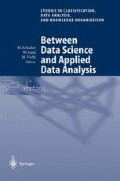Abstract
The indeterminacy in the horizontal ordering of the objects in the usual tree diagram representation of a dendrogram, and the associated dangers of misinterpretation, are well-known. A systematic choice of ordering is presented and seen to have a variety of attractive features. In particular, it induces a strengthened form of the Robinson property of the associated ultrametric matrix, permitting an exact one dimensional visual display of maximal subsets of objects. These systematic orderings are based upon the ziggurat decomposition of an arbitrary binary dendrogram. Worked examples motivate and illustrate the development. Connections with ‘chaining’ in single-link hierarchical cluster analysis are noted.
Access this chapter
Tax calculation will be finalised at checkout
Purchases are for personal use only
Preview
Unable to display preview. Download preview PDF.
References
CRITCHLEY, F. (1983): Ziggurats and dendrograms. University of Warwick Statistics Research Report, 43.
CRITCHLEY, F. (1988): The Euclidean structure of a dendrogram, the variance of a node and the question: ‘How many clusters really are there?’. In: H. H. Bock (Ed.): Classification and Related Methods of Data Analysis. Elsevier, North-Holland, 75–84.
CRITCHLEY, F. and FICHET, B. (1994): The partial order by inclusion of the principal classes of dissimilarity on a finite set, and some of their basic properties. In: B. Van Cutsem (Ed.): Classification and Dissimilarity Analysis, Lecture Notes in Statistics, 93. Springer, New York, 5–65.
CRITCHLEY, F. and VAN CUTSEM, B. (1994): An order-theoretic unification and generalisation of certain fundamental bijections in mathematical classification — I. In: B. Van Cutsem (Ed.): Classification and Dissimilarity Analysis, Lecture Notes in Statistics, 93. Springer, New York, 87–119.
DIGBY, P. G. N. (1984): Dendrograms and ziggurats. Genstat Newsletter, 14, 14–18. Numerical Algorithms Group, Oxford.
GOWER, J. C. (1968): Multivariate analysis and multivariate geometry. The Statistician, 17, 13–28.
HOLMAN, E. W. (1972): The relation between hierarchical and Euclidean models for psychological distance. Psychometrika, 37, 417–423.
JARDINE, N. and SIBSON, R. (1971): Mathematical Taxonomy. John Wiley, London.
MAHALANOBIS, P. C., MAJUMDAR D. M. and RAO, C. R. (1949): Anthropometric survey of the United Provinces. Sankhyii, 9, 89–324.
VAN CUTSEM, B. (1983): Decomposition d’une ultrametrique: ultrametriques simples et semi-simples. Laboratoire IMAG (Grenoble) Rapport de Recherche, 388.
Author information
Authors and Affiliations
Editor information
Editors and Affiliations
Rights and permissions
Copyright information
© 2003 Springer-Verlag Berlin Heidelberg
About this paper
Cite this paper
Critchley, F. (2003). On Ziggurats and Dendrograms. In: Schader, M., Gaul, W., Vichi, M. (eds) Between Data Science and Applied Data Analysis. Studies in Classification, Data Analysis, and Knowledge Organization. Springer, Berlin, Heidelberg. https://doi.org/10.1007/978-3-642-18991-3_22
Download citation
DOI: https://doi.org/10.1007/978-3-642-18991-3_22
Publisher Name: Springer, Berlin, Heidelberg
Print ISBN: 978-3-540-40354-8
Online ISBN: 978-3-642-18991-3
eBook Packages: Springer Book Archive

